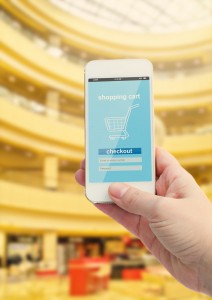By Erica Rascón on April 28, 2015 in News
Large retail centers used to be revered for their prestige and variety. Getting to the 2 million-square-foot Sears and Roebuck center in Atlanta, GA was once a pilgrimage for consumers throughout the region. The days of such super-sized department stores are long gone. With the growing popularity of online shopping, brick-and-mortar stores are steadily shrinking. This trend is likely to continue but that doesn’t mean that REITS and owners will see less cash flow from their vast, existing properties. Data leasing, the new frontier, is proving to be a gold mine full of possibilities.

CBL & Associates is introducing the Digital Star program at its properties. It is a set of fiber paths, routers, and related infrastructure that is made available to tenants in CBL properties. Three shopping centers are piloting Digital Star this year.
“The new space for lease is all digital,” says Mike Harrison, Senior Vice President at CBL. “It’s a whole new way of thinking. It’s in high demand.” The average demand ranges from 4-10 megabytes for most retailers but there are tenants such as Microsoft and Apple that need well over 100 megabytes.
To meet the growing demand, CBL has teamed up with Granite Communications to provide data management and services. Together, they offer tenants brick-and-mortar stores with a range of digital capabilities.
The duo is constantly thinking on its feet. The need for data will only increase as retailers explore methods in which digital and online tools can enhance the customer experience and improve the efficiency of operations.
Consumers motivate the bulk of data demands. Even when they are inside of a store, consumers continue to shop and research online for product reviews, detailed product descriptions, and offers from competitors.
In addition to in-store wi-fi, consumers expect increasingly interactive shopping experiences. Throughout Asian metropolises, touchscreen panels are blurring the distinction between in-store and online shopping. Consumers use virtual shingles—touchscreen wall displays of various sizes—to shop online while they’re at the mall. The technology is slowly inching its way to North America.

Virtual shingles are a new way for consumers to obtain the products they desire while minimizing the retailers’ need for square footage.
Virtual shingles may also provide consumers with access to stores that otherwise would not invest in their market. “In middle markets, which we generally work in, some of the higher-end retailers may want to tap into that very small percentage of consumers but they don’t want to come in and put in a whole store. We see the virtual concept might be of use there,” explains Harrison.
There are also familiar data-based services that are becoming more sophisticated. Retailers request greater bandwidth for on-site entertainment. Rather than playing CDs or a local radio station, stores stream customized playlists through their sound systems as well as live broadcasts of events.
Some retailers will soon want to implement virtual dressing rooms. Touchscreen panels take pictures of customers and allow them to wear clothing and accessories in the store without putting the products on their bodies. Such innovations can reduce thefts, preserve the integrity of merchandise, and decrease the square footage required for the store to function normally.
Behind the scenes, retailers require significant bandwidth for in-store technologies. Sales representatives check product availability, place orders and other functionalities that help nationwide stores feel more like a cohesive unit. Sales representative also use the Internet to research complimentary products and services, to upsell on transactions that are taking place in the store.
Another hot data-based service is digital advertising. Beacon technologies track and monitor consumer activity and then offer timely, rele vant incentives via push notifications.
vant incentives via push notifications.
While popular tech companies are already making strides in this arena, CBL believes it is too deep of a well to outsource its potential to third parties. The company is working to develop its use of beacons through the Common Area Matrix.
“We believe that owning virtual common areas in the grid is about, ‘Can we lease that space to someone who wants to push advertise?’ We believe that can be an opportunity for us. Can you imagine walking up to an H&M and the cloud knows where you’re at and what your buying habits are? Just in time, an ad is pushed to your phone and it says, ‘Across the mall, your blue jeans are 20% off.’ There is real value in being able to capture and redirect that consumer. We think there is a way to monetize that,” says Harrison.
Owners have found third party carriers creeping into this market on their sites. “We’ve been bombarded with the carriers—Comcast, Verizon, AT&T—a few of them have actually slipped into our malls and strapped in the fiber because they knew the demand existed and they wanted it. They wanted to cut us out of the offer by making a low monthly fee or something. We’ve had to set up barriers,” says Harrison.
One way to keep data services in house is to provide better customer service and faster response times than tenants can get with the third party carriers. “We recommend Granite to our tenants but it’s not required, though there is significant value added; […] when our tenants set up cart kiosks, sometimes it takes AT&T 60 days to get a line put in but ours is done that week.”
Data leasing is in its nascent stages in North America, leaving local pioneers to look to Europe and Asia for new developments and ideas. But one thing is clear: as the technology develops, REITS and owners must find a way to monetize the virtual realm within their stores before third party carriers sweep the gold from under their feet.


